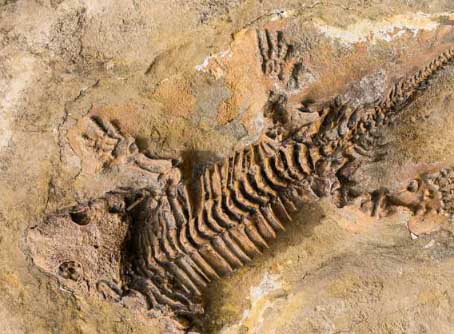Prehistoric whales were born on the beach

Early whales lived between land and ocean – hunted in the water, and they multiplied and bore offspring on land. Recent studies of fossilized whale bones speak of this, how these powerful mammals adapted to life in the water – paleontologists write in the pages “Public Library of Sciences”. The examined bones come from before 47,5 million years. It is the skeleton of a pregnant female and that of a male of the same species. The discovery was made in Pakistan in a year 2000 i 2004. “When we were digging in the position, we saw small teeth, I thought, that it is a small adult whale – says the co-author of the article, Philip Gingerich z University of Michigan. – Later though, as it digs, we exposed the ribs, which seemed disproportionately larger compared to the teeth. At the end of the day, I realized, that it's a female with a fetus inside”. This is the first discovery of a fetal skeleton belonging to the extinct Archaeoceti whales. The find turned out to be a new species, which was given the name Maiacetus inuus. “Maiacetus” means “mother whale”, and Inuus is the name of the Roman god of fertility. The fetus looks like this, that the head would come out first during childbirth. It is similar in land mammals, but different with today's whales.
According to the researchers, means, that the whales of that time still gave birth on land. Another feature of the way of life of early whales, are well-developed teeth in a fetus. Newborns of the Maiacetus species ate independently from the very beginning. Four years later, a male skeleton was recovered from the same paleontological site.
In terms of anatomical features, it had many similarities with the female, however, it was approx. 12 proc. greater, his fangs, in turn, were longer by 20 proc. Such differences are not uncommon among whales. In some species the female is larger, in others, the male. The Maiacetus species differed only slightly in size. It follows from here, that the males did not have a female harem – the researchers explain.
In their opinion, pre-whale teeth – large and perfectly suited for catching and eating fish – may attest to this, that animals lived and fed in the sea, going ashore probably just to rest, find a mate and give birth to children. Like other primitive whales, Maiacetus had four legs adapted to swimming. On land, however, the legs were too weak for longer hikes.
– These animals were tied to the coast. They lived on the border between land and sea – explains Gingerich. Compared to previous whale finds, Maiacetus occupies an intermediate position on the evolutionary path from terrestrial animals to deep inhabitants. Thanks to this, it provides invaluable information on changes in construction and habits, that accompanied this evolutionary process.











